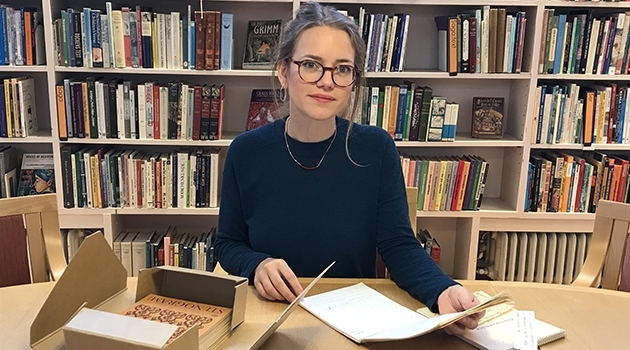New study reveals unknown side of Astrid Lindgren’s creative process
Why did Jonathan Lionheart’s pitch-black hair suddenly turn golden? And how did Master Detective Kalle Blomqvist get his proper name? In the “Astrid Lindgren Code”, literature researcher Malin Nauwerck lifts the lid on some of the literary world’s most sought-after secrets.
“Astrid Lindgren’s original manuscript opens up a previously unknown dimension of her authorship. In the drafts for The Brothers Lionheart, we see the great care Lindgren takes in describing the battle between the dragon Katla and the sea-serpent Karm. In its first guise, the scene had already appeared in her War Diaries 1939–1945; but here, more curious details were also included – such Jonathan Lionheart’s golden hair being black in an early version of the first chapter.”
Malin Nauwerck, a literary scholar, has been running the Astrid Lindgren Code project since New Year. In it, she heads the deciphering of the author’s extant notebooks: a fabled and essentially unexplored literary treasure that allows us to follow Lindgren’s creative process, from early ideas to finished novel.
“These manuscripts have long been seen as the key to new advances in research on Astrid Lindgren. The explanation for why no one has taken on the task is that Lindgren wrote in shorthand, given the well-established view that her stenography was almost impossible to decode. When we started examining the material to see whether using digital methods to interpret it was feasible, we saw that manual reading, too, was relatively simple if you know shorthand.”
below, under FACTS)
The process started with The Brothers Lionheart, the book of hers that, in correspondence, Lindgren described as the hardest to complete. The dark tale of Karl, the boy with tuberculosis, and his courageous elder brother Jonathan came into being under trying personal circumstances for her, including the death of Lindgren´s own brother, Gunnar. There are a total of 52 notepads, containing huge numbers of crossings-out and insertions, but also different versions of the beginning and ending.
“The Brothers Lionheart is a highly radical book, with an ending that still shocks the reader, As Lindgren expressed it, she decided early on that Jonathan’s initial sacrifice – heroically rescuing Karl from a fire – had to be offset at the end of the story by a comparable action. How she eventually settled on the ambiguous ending is therefore especially interesting to investigate,” Nauwerck says.
Kalle Karlsson, the “Master Detective”
There is also a suggestion in one of the notepads that Master Detective Kalle by no means started off as “Blomqvist”. Instead, his creator chose to save her planned surname, Karlsson, for little Smidge, her 1949 brainchild, and especially a certain propeller-driven, “perfectly plump” man in his prime.
“In the project, we’re also going to digitally analyse a more accessible set of material, with few personal notes, that Lindgren herself donated to research. This will be a valuable indicator of how our digital transcription methods can work on Lindgren’s shorthand generally. Studying these two manuscripts may be seen as a pilot project. If it’s successful, we intend to explore Astrid Lindgren’s works further. They hold lots of mysteries waiting to be solved. As for myself, I’m very interested in the many similarities between The Lord of the Rings and Mio, My Son, which was published in the same year!”
The Astrid Lindgren Code is already arousing great interest in several fields of scholarship. The manuscripts she left behind make up one of the world’s largest collections of material written in shorthand. The hope is that the tool for digital text identification and transcription currently being devised by Anders Hast, Professor of Computerised Image Processing at Uppsala University, will pave the way for more studies of handwritten documents.
“We look forward to being able to put our results out there. Above all, we want to make transcripts of the manuscripts available for further research and, in response to the keen public interest, we’re also thinking in terms of a digital exhibition. But all that lies ahead of us. Right now, we’re grateful for the opportunity we’ve been given to solve Astrid Lindgren’s own code.”
Magnus Alsne
Facts
- The Astrid Lindgren Code is an interdisciplinary collaboration between Uppsala University and the Swedish Institute for Children’s Books.
- The project will continue until 31 December 2022, with funding from Riksbankens Jubileumsfond, an independent foundation that serves to promote and support research in the Humanities and Social Sciences.
- The working group’s members are: Malin Nauwerck, literature researcher, at the Swedish Institute for Children’s Books, affiliated to Uppsala University; Anders Hast, Professor of Computerised Image Processing, Uppsala University; Raphaela Heil, PhD student at the Department of Information Technology, Uppsala University; Karolina Andersdotter, librarian specialising in digital methods, Uppsala University Library and Britt Almström, Riksdag stenographer.
- Astrid Lindgren used the Melin system of shorthand, which was long used extensively in Sweden. Melin shorthand is based on sound frequency in the Swedish language, and takes the form of phonetically drawn pictograms.
- Example from the transcription image (deleted text in brackets): “... I must tell the story of my brother (yes, I want to tell it) of my brother Jonathan Lionheart I want to tell it yes I think it’s almost like a saga (although some people would think it’s like a ghost story or whatever) and a little bit like a ghost story too (anyway I’m the only one who knows the whole lot is true) although there’s probably no one but me who knows that…” (published with permission from Astrid Lindgren AB)

